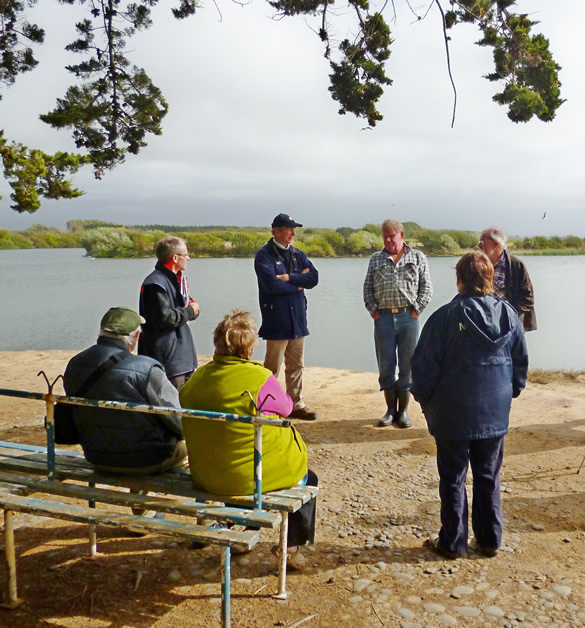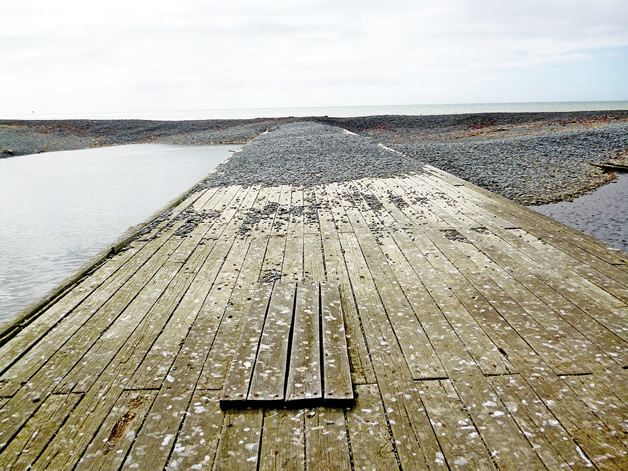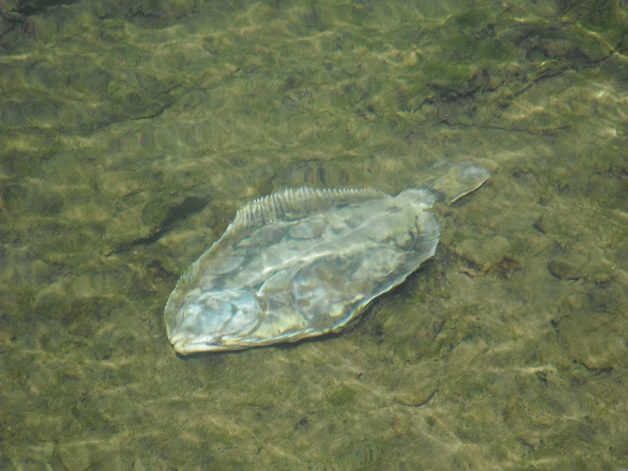Waihao committee members met with Environment Canterbury engineering staff members, Bruce Scarlett and Ross Vessy, at the Waihao box on 11 March, to discuss matters relating to the Box and its future.
Waihao’s manager Steve Boyd, Graeme and David Thomas and Jennifer Thomas and her partner Angus travelled to the Box and were met there by Graeme Lane, our chair. Local farmer representative Mick Lamming also joined the group.
The Box, as it is known locally, is a long, rectangular structure allowing the river to flow underneath the main part of the shingle bank before it emerges near the sea, scouring a small area of shingle and maintaining a natural shift. In a clever piece of engineering, the Box works so that when the river flow is high, the water will spill out of the north side, creating a natural channel.
This historic landmark – now 103-years-old – is an ingenious structure that helps create an opening through the gravel beach to the sea, for the Waimate District’s Waihao River. Funded by local farmers and built in 1910, it has been integral to preventing flooding of valuable farmland and it helps maintain the health of a natural wildlife habitat of national importance, the Wainono Lagoon.
It’s an important piece of engineering and is the only functioning box of its kind in New Zealand. Environment Canterbury took over the management of the Box from locals in 1996.
It was pointed out to us that the outer end of the Box as it exists now is becoming more dangerous with the passage of time with temporary repairs, rotting iron bolts and splitting timbers all becoming more unstable and at risk of collapse with possibly tragic consequences. It was also pointed out that the Box jutting out into the sea is also holding up the natural flow of gravel along the beach by acting as a groyne.
Environment Canterbury presented their proposals to us for consideration, suggestions and support before taking them to the wider public.
We were surprised to note that 30 or so ratepayers are responsible for the costs related to maintenance and the opening of the river when it is deemed necessary. Mick Lamming pointed out that the estimated cost of removing the outer or seaward end of the Box, restructuring and adding to the inner end, is expected to be around $800,000 and to date they have set aside $100,000 toward the cost.
This project is not without its complications due to someone having registered it under the Historic Places Act. It is interesting to note that the only section of the Box which is actually ‘historic’ is the outer end, which is the section which needs to be removed due to deterioration.
Although not mentioned at the meeting, we believe the Box is a unique structure which must be protected. At the same time, we must compromise with Environment Canterbury to ensure its safety and maximum effectiveness, the latter being of questionable value. Nonetheless the Box is an iconic landmark that it has been there for over a hundred years. Although the original structure has long since disappeared into the sea, its extensions back into the river still represent its originality and purpose, and provide a visual reminder of a unique landmark.
For the peoples from Māori Road and Glenavy, the Waihao Box is a familiar friend and the fishing stories surrounding it span over a century. It is stated that Dave Thomas took his new bride on their honeymoon for a midnight rowboat ride under the Box, much to her consternation, as she had no idea where she was and the sound of the sea crashing beside her must have been disconcerting.
For the reasons above, I am sure that the wider Waihao whānau who know the Waihao River and Box intimately would support its protection. We want it to be a safe environment for the hundreds who visit it and as such, we will attend all meetings to remain informed and to have our input into the Box’s future.
For another more sinister reason, it was fortuitous that this meeting took place, as the river is in such poor shape – the results no doubt, of farming practices and land being developed and farmed to the water’s edge. This means pesticide and herbicide run off along with fertilizer and effluent run off and associated nutrients enter the waterways.
The Environment Canterbury staff, together with us, could not help noticing the putrid brackish waters, scum rotting on the surface and the filthy mud bottom, where 40 years ago clear water and clean gravel existed. More than anything else though, it was the two dead mullet lying in the river that was most distressing. One was the largest mullet I had ever seen in the Waihao.
These things reminded me of December 2012, when Sarah and Rebekah Thomas, Dave Thomas, John Wilkie and myself observed two dead flounders in the water up at Bradshaws Bridge. These dead fish should encourage us to consider what is going wrong with our waterways and what we can do about it.
The state of the river is such that many questions need answering and many injustices need to be rectified; and Ngāi Tahu as an iwi must work together to ensure that our rivers and waterways are cleaned up and returned to their original pristine states. Farmers and land owners who put money and greed before the environment, should be made to clean up their act and set aside buffer strips of land alongside the waterways to ensure our food gathering resources are protected forever.
Nā Graeme Thomas.

Left to right: Graham Thomas, Ross Vesey, Bruce Scarlet, Mick Lamming, Jennifer Thomas. Seated from left: Dave Thomas, Lynne Davis.

The Waihao Box, taken from the inner end, looking past the pebble bank out to sea.

Dead pātiki in Waihao River.